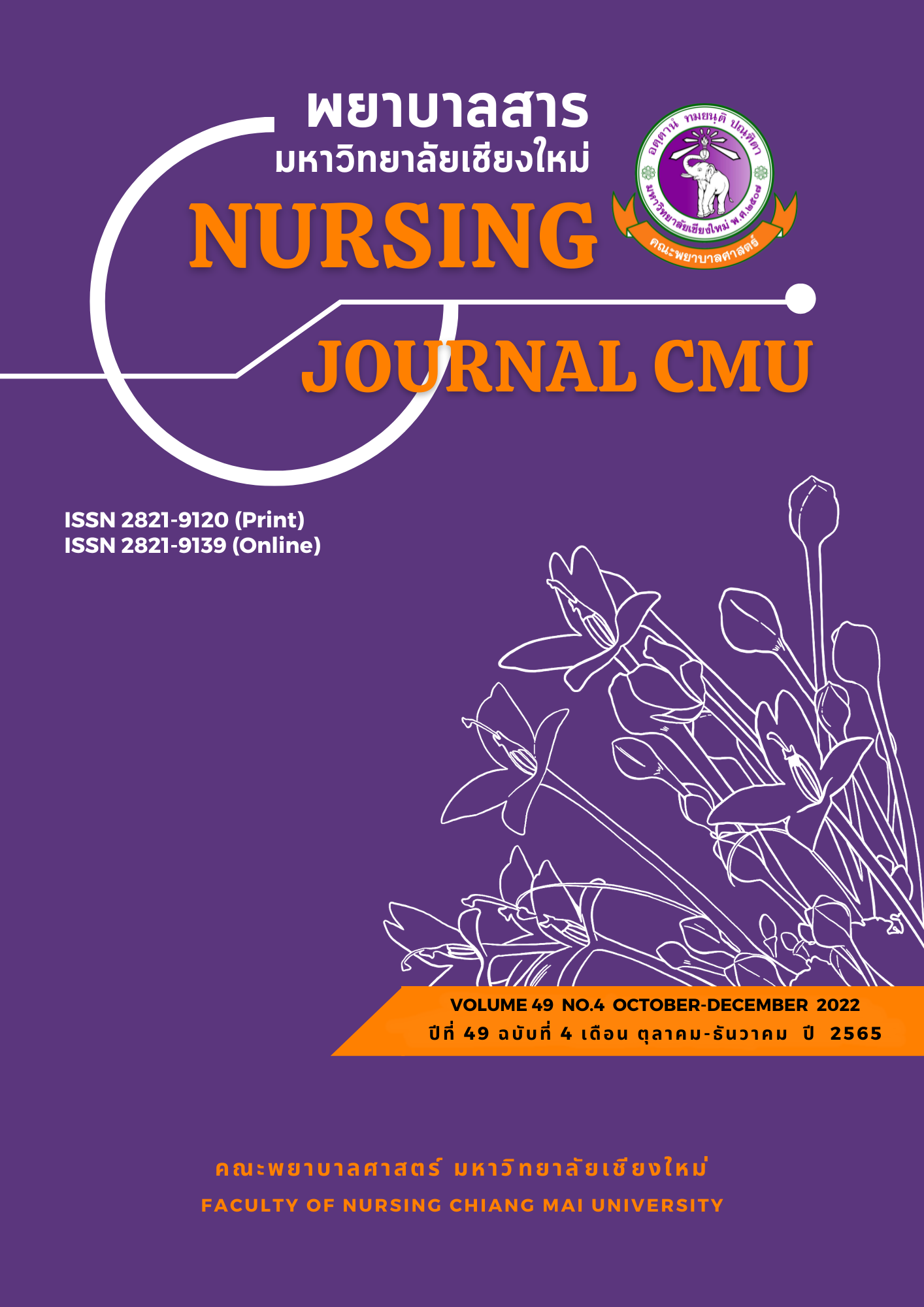The Effects of a Peripheral Intravenous Infusion Program on the Compliance Behaviors of Preschool Children
Keywords:
Compliance behavior, Peripheral intravenous infusion, Preschool childrenAbstract
This quasi-experimental study aimed to study the effects of a peripheral intravenous infusion program on compliance behaviors. Subjects were preschool children admitted to pediatric wards with 20 subjects in each group. The experimental group received a peripheral intravenous infusion program, while the control group received routine nursing care. The research instruments consisted of the peripheral intravenous infusion program, and a compliance behavioral observation form which yielded respective content validity. The inter-rater reliability of the observation form was 0.97. Descriptive statistics and an independent sample t-test were used to analyze the data.
The results revealed that the mean scores for compliance behavior in peripheral intravenous infusion among the experimental group were higher than those of the control group (p < .05). When classified by situation, the experimental group and the control group had no difference in mean scores for compliance behaviors before the instillation of the solution. However, while inserting the catheter into the blood vessel and after retaining the vascular salvage tube to provide the solution, the mean scores for compliance behaviors in peripheral intravenous infusion among the experimental group were higher than those of the control group (p < .05).
Certainly, the peripheral intravenous infusion program can increase compliance behaviors and prevent complications during the peripheral intravenous infusion of preschool children. The results of this study will be beneficial for preschool pediatric patients in preparation for peripheral intravenous infusion procedure.
References
Choosrijun, W., & Chaiyawat, W. (2018). Effects of aerosol spray cooperation promoting program on aerosol spray cooperation of preschool patients with acute respiratory infection. Journal of Police Nurses, 10(2), 233-243. (in Thai)
da Silva, J. R. S., Pizzoli, L. M. L., do Prado Amorim, A. R., Pinheiros, F. T., Romanini, G. C., da Silva, J. G., ... Alves, S. S. (2016). Using therapeutic toys to facilitate venipuncture procedure in preschool children. Pediatric Nursing, 42(2), 61-68.
Fielding, D., & Duff, A. (1999). Compliance with treatment protocols: Interventions for children with chronic illness. Archives of Disease in Childhood, 80, 196-200.
Hockenberry, M. J., Wilson, D., & Rodgers, C. C. (2019). Wong’s nursing care of infants and children (11th ed.). St. Louis: Mosby Elsevier.
Jin, J., Sklar, G. E., Oh, V. M. S., & Li, S. C. (2008). Factors affecting therapeutic compliance: A review from the patient’s perspective. Therapeutics and Clinical Risk Management, 4(1), 269–286. doi: 10.2147/TCRM.S1458
Khamenkan, K. (2012). Intravenous cannulation procedure in pediatric patients: Nursing strategies to success. Journal of Nursing Science and Health, 35(2), 131-139. (in Thai)
Khungtumneam, K. (2014). The strategies for promoting illness pre-school age development during hospitalization. HCU Journal, 17(34), 155-167. (in Thai)
Khuttamasoon, T., Jirapeat, V., & Ua-Kit, N. (2015). The effect of pediatric patient preparation combined with computer-assisted instruction program on compliance behavior in peripheral intravenous infusion among school-age children. Journal of The Royal Thai Army Nurses, 16(1), 70-77. (in Thai)
Lim, S. H., Kim, M. J., & Lee, M. J. (2013). Use of animated cartoons with children's songs to increase compliance with ultrasonography in young children. Yonsei Medical Journal, 54(6), 1533-1537. doi: 10.3349/ymj.2013.54.6.1533
Molu, B., & Açıkgöz, A. (2022). A randomized controlled study: The effect of preprocedurals ınformative animation watch about echocardiography and intraprocedural kaleidoscope watch on anxiety in children. Japan Journal of Nursing Science, 19(2), e12468. doi: 10.1111/jjns.12468
Ouzouni, A., Galli-Tsinopoulou, A., Kyriakos Kazakos, M. D., & Maria Lavdaniti, R. N. (2019). Adolescents with diabetes type 1: Psychological and behavioral problems and compliance with treatment. International Journal of Caring Sciences, 12(2), 1298-1304.
Pavarojkit, P., Chandarasiri, P., & Buathong, N. (2019). Therapeutic play for children coping with stress underwent venipuncture at King Chulalongkorn Memorial Hospital. Chulalongkorn Medical Bulletin, 1(4), 323-335. (in Thai)
Petchlek, P., Suwanvala, S., & Suwanvala, P. (2021). Effects of a storytelling program with a three-dimensional book on preschool children’s fear of receiving aerosol therapy. The Southern College Network Journal of Nursing and Public Health, 8(1), 41-52. (in Thai)
Polit, D. F. (2014). Statistics and data analysis for nursing research (2nd ed.). Harlow, England: Pearson.
Purachakueng, S., Tripanom, N., Kiatchoosakun, P., Taksaphan, S., & Jirapradittha, J. (2012). Practice guideline for prevention of intravenous leakage. In V. Jirapaet, & K. Jirapaet (Eds.), Patient safety management concepts, process and clinical practice guideline. Bangkok: Darnsutha Press. (in Thai)
Rongmuang, D., Narkchuttri, C., Rodsri, P., Meesri, S., Klubchum, W., Thongsuk, W., … Samerpark, S. (2014). Using two-dimension cartoon animation in order to prevent the “hand, foot and mouth disease” (HFMD) among pre-school children: Knowledge for practice in preventing HFDM. The Southern College Network Journal of Nursing and Public Health, 1(1), 29-41. (in Thai)
Rueangworaboon, S., & Prabmeechai, S. (2016). The effect of role play with the invented doll on fear from intravenous fluid Infusion in pre-school children. Nursing Journal of the Ministry of Public Health, 25(3), 144-154. (in Thai)
Sanders, M. R., Turner, K. M., & Metzler, C. W. (2019). Applying self-regulation principles in the delivery of parenting interventions. Clinical Child and Family Psychology Review, 22(1), 24-42. doi: 10.1007/s10567-019-00287-z
Supsung, A., Khunkaew, S., & Udomlerd, M. (2017). Managing fear needle pain in children: Nursing practice in pediatric care. Journal of The Royal Thai Army Nurses, 18 (suppl.2), 25-31. (in Thai)
Szeszak, S., Man, R., Love, A., Langmack, G., Wharrad, H., & Dineen, R. A. (2016). Animated educational video to prepare children for MRI without sedation: Evaluation of the appeal and value. Pediatric Radiology, 46(12), 1744-1750.
Downloads
Published
How to Cite
Issue
Section
License
Copyright (c) 2022 Nursing Journal

This work is licensed under a Creative Commons Attribution-NonCommercial-NoDerivatives 4.0 International License.
บทความที่ได้รับการตีพิมพ์เป็นลิขสิทธิ์ของวารสารพยาบาลสาร
ข้อความที่ปรากฏในบทความแต่ละเรื่องในวารสารวิชาการเล่มนี้เป็นความคิดเห็นส่วนตัวของผู้เขียนแต่ละท่านไม่เกี่ยวข้องกับมหาวิทยาลัยเชียงใหม่ และคณาจารย์ท่านอื่นๆในมหาวิทยาลัยฯ แต่อย่างใด ความรับผิดชอบองค์ประกอบทั้งหมดของบทความแต่ละเรื่องเป็นของผู้เขียนแต่ละท่าน หากมีความผิดพลาดใด ๆ ผู้เขียนแต่ละท่านจะรับผิดชอบบทความของตนเองแต่ผู้เดียว






